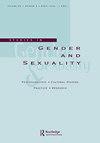跨性别群体治疗中治疗师自我表露的困境
Q3 Social Sciences
引用次数: 0
摘要
摘要治疗师自我揭露可以成为临床工作中一种强大但高度个人化的工具。特别是对于LGBTQ+患者,治疗师对LGBTQ+identity的自我披露可能会促进赋权并建立联盟。它还可能存在错位和擦除的风险。治疗师保持沉默可能会集中患者的体验;它也可能是治疗师内在压迫的模型。小组设置和形式,以及治疗师自己在专业和个人领域的身份发展阶段,使这一点更加复杂。这种困境是通过我在博士培训期间作为一名酷儿治疗师领导的一个跨性别学生支持小组的案例介绍来考虑的。该案例和随后的反思质疑了对治疗师自我披露的二元、固定视角的必要性,因为身份和关系不是静态的,而是不断变化的。本文章由计算机程序翻译,如有差异,请以英文原文为准。
The Dilemma of Therapist Self-Disclosure in Transgender Group Therapy
ABSTRACT Therapist self-disclosure can be a powerful yet highly personal tool in clinical work. Specifically for LGBTQ+ patients, the therapist’s self-disclosure of LGBTQ+ identity may foster empowerment and build the alliance. It may also risk misattunement and erasure. The therapist remaining silent may center the patient’s experience; it may also model the therapist’s internalized oppression. This is further complicated by the group setting and format, as well as the therapist’s own stage of identity development in both professional and personal spheres. This dilemma is considered through a case presentation of a trans student support group I led as a queer therapist during my doctoral training. The case and subsequent reflection question the need for a binary, fixed perspective on therapist-self disclosure, as identity and relationship are not static but ever-changing.
求助全文
通过发布文献求助,成功后即可免费获取论文全文。
去求助
来源期刊

Studies in Gender and Sexuality
Social Sciences-Gender Studies
CiteScore
0.80
自引率
0.00%
发文量
15
期刊介绍:
Beginning in the final two decades of the 20th century, the study of gender and sexuality has been revived from a variety of directions: the traditions of feminist scholarship, postclassical and postmodern psychoanalytic theory, developmental research, and cultural studies have all contributed to renewed fascination with those powerfully formative aspects of subjectivity that fall within the rubric of "gender" and "sexuality." Clinicians, for their part, have returned to gender and sexuality with heightened sensitivity to the role of these constructs in the treatment situation, including the richly variegated ways in which assumptions about gender and sexuality enter into our understandings of "normality" and "pathology."
 求助内容:
求助内容: 应助结果提醒方式:
应助结果提醒方式:


